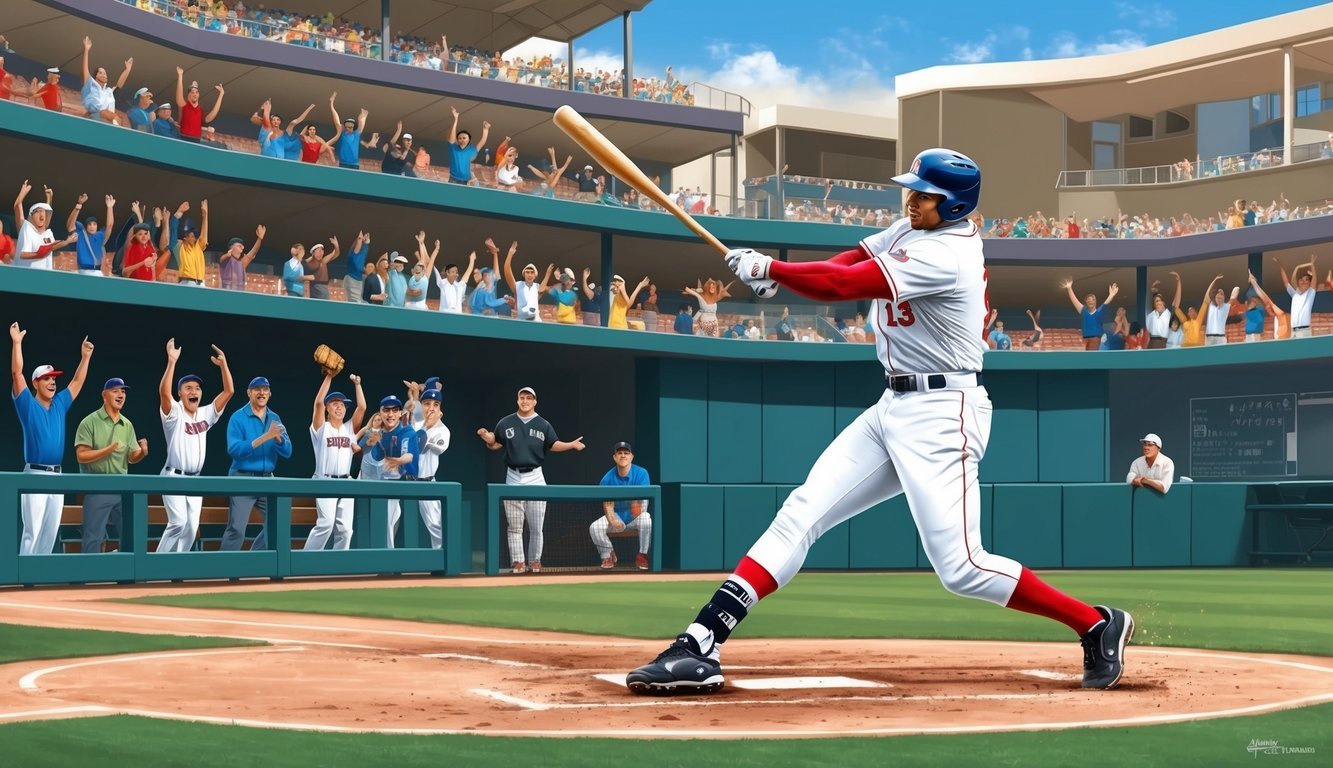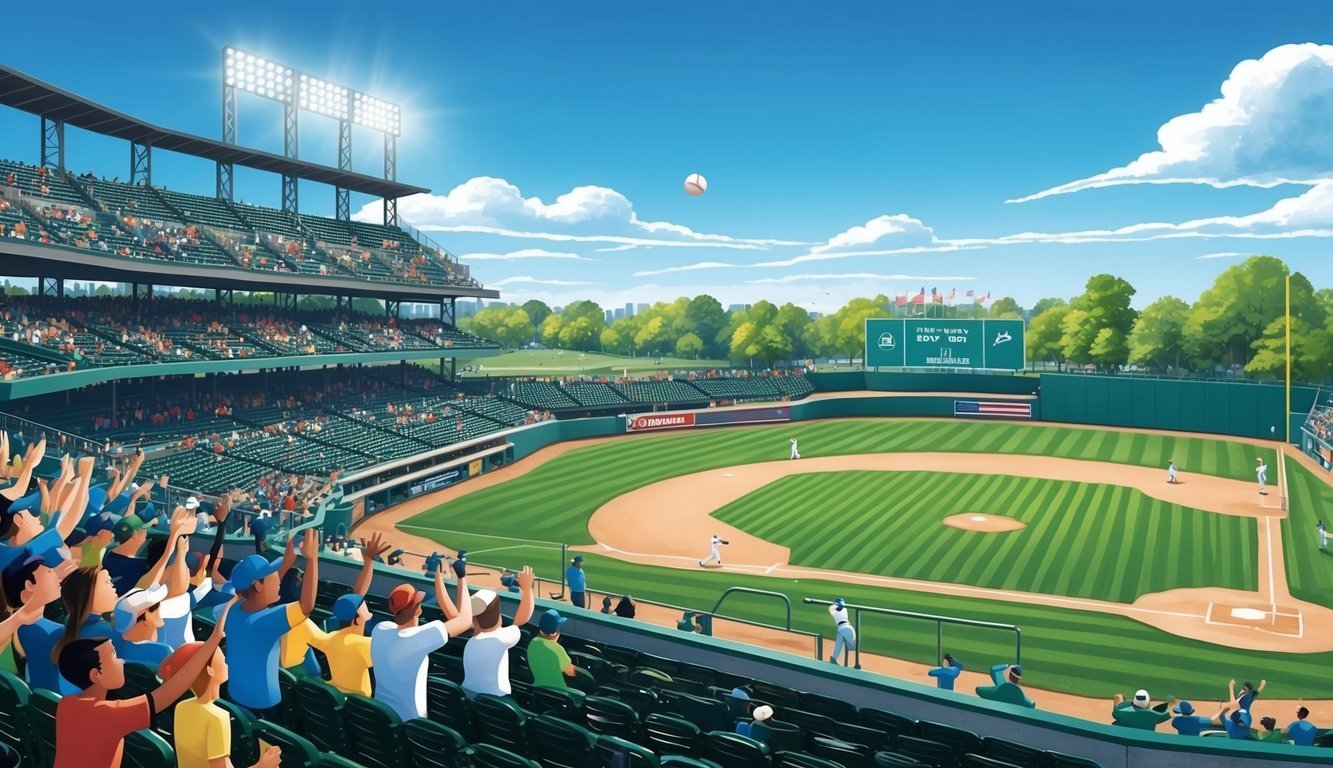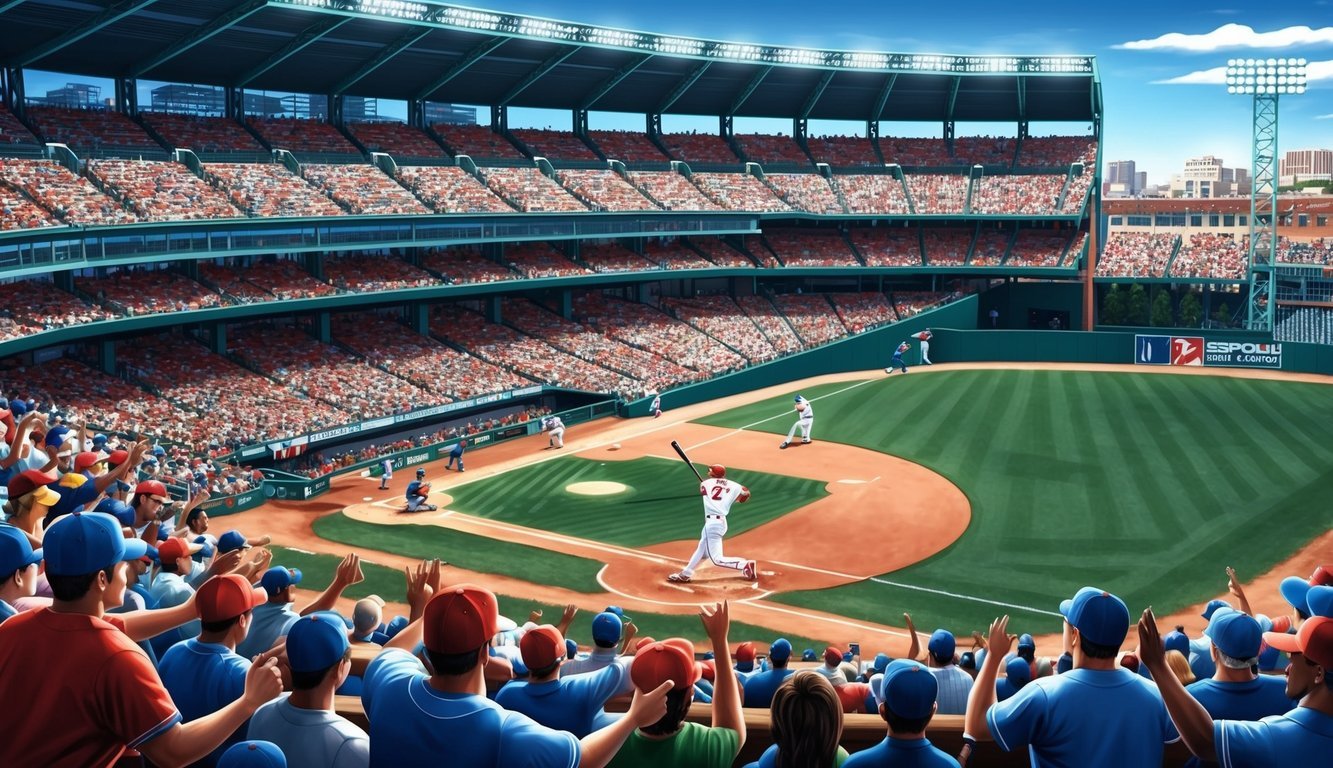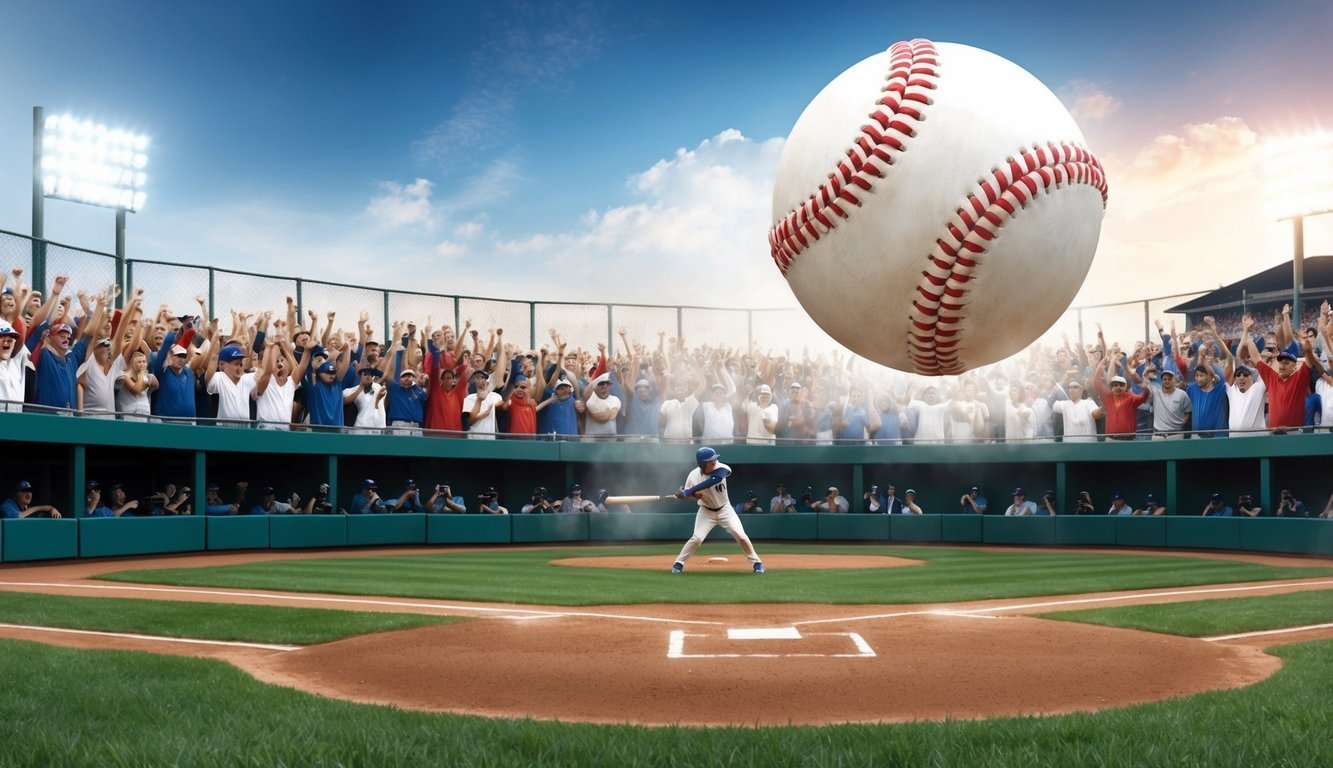Baseball fans love tracking records, and few are as exciting as the single-season home run mark.
The pursuit of this coveted achievement has captivated audiences for decades.
Barry Bonds holds the all-time record for most home runs in a season with 73, set in 2001. This incredible feat surpassed the previous marks of 70 by Mark McGwire and 66 by Sammy Sosa, both established during the memorable 1998 season.
The race for the American League single-season home run record saw a new chapter in 2022.
Aaron Judge of the New York Yankees hit 62 home runs, surpassing Roger Maris’ long-standing AL record of 61 set in 1961.
Judge’s historic season reignited interest in the home run chase and reminded fans of baseball’s enduring appeal.
Single-Season Home Run Record
The single-season home run record has captivated baseball fans for decades, with several legendary sluggers etching their names in the history books.
This prestigious mark has evolved over time, featuring some of the game’s greatest power hitters.
One of the most exciting aspects of the record chase is the drama that unfolds as players approach the milestone, captivating fans and analysts alike.
Throughout history, sluggers have pushed the boundaries of power hitting, showcasing incredible skill and determination.
While discussing legendary players, many fans also take an interest in the financial success of top athletes, often searching for information like Bryce Harper net worth to gauge the impact of star players both on and off the field.
Historical Progression
Babe Ruth set the bar high in 1927 with 60 home runs.
This record stood for 34 years until Roger Maris hit 61 in 1961.
Maris’s achievement sparked controversy due to the extended 162-game season.
In 1998, the baseball world witnessed an epic home run chase.
Mark McGwire and Sammy Sosa both surpassed Maris, with McGwire finishing at 70 and Sosa at 66.
The excitement brought fans back to ballparks in droves.
Just three years later, Barry Bonds shocked everyone by smashing 73 home runs in 2001.
This remains the current single-season record.
Bonds’s incredible feat has been subject to scrutiny due to performance-enhancing drug allegations.
Memorable Seasons
The 1998 season stands out as one of the most thrilling in baseball history.
McGwire and Sosa traded blows all summer, captivating the nation.
Their friendly rivalry and pursuit of Maris’s record helped revitalize the sport after the 1994 strike.
In 2001, Bonds’s record-breaking season was a display of unparalleled power.
He hit a home run every 6.52 at-bats and finished with an astronomical .863 slugging percentage.
His performance redefined what was possible for a single-season power output.
More recently, Aaron Judge made headlines in 2022.
He hit 62 home runs, setting a new American League record and surpassing Maris’s 61-year-old mark.
Judge’s chase brought renewed interest to the home run record.
Influential Players and Their Achievements
Baseball’s home run kings have left an indelible mark on the sport.
Their incredible feats have thrilled fans and inspired generations of players.
Career Milestones
Hank Aaron smashed 755 home runs over his illustrious career, holding the all-time record for decades.
Babe Ruth’s 714 homers set a seemingly unbreakable standard.
Barry Bonds ultimately surpassed both with 762 career long balls.
Ken Griffey Jr. dazzled fans with his sweet swing, belting 630 homers.
Alex Rodriguez finished with 696, narrowly missing the exclusive 700 club.
Albert Pujols joined that elite group in 2022, retiring with 703 home runs.
Giancarlo Stanton leads active players with 428 homers as of 2024.
His prodigious power suggests he may climb higher on the all-time list.
Impact on Teams
Home run hitters often become the face of their franchises.
Jimmie Foxx’s power helped the Philadelphia Athletics win three straight pennants from 1929-1931.
Mickey Mantle’s switch-hitting prowess propelled the Yankees to seven World Series titles.
David Ortiz became a Boston icon, his clutch homers leading the Red Sox to three championships.
His 541 career homers rank him among the all-time greats.
Teams build lineups around these sluggers.
Their presence changes how pitchers approach batters, creating opportunities for teammates.
Home run hitters also boost ticket sales and merchandise revenue, making them valuable on and off the field.
Statistical Analysis of Home Run Achievements

Home run statistics provide crucial insights into a player’s power-hitting abilities and overall offensive impact.
Key metrics and historical comparisons help evaluate the significance of home run achievements across different eras of baseball.
Understanding Key Metrics
Home runs per game (HR/G) is a valuable measure of a player’s power-hitting consistency.
This metric allows for fair comparisons between players with different numbers of games played in a season.
Slugging percentage (SLG) reflects a batter’s total bases per at-bat, with home runs significantly boosting this stat.
A high SLG often correlates with prolific home run hitters.
On-base plus slugging (OPS) combines on-base percentage and slugging percentage, offering a comprehensive view of a player’s offensive contributions.
Runs batted in (RBI) totals typically increase with home run production, though they also depend on teammates’ ability to get on base.
Comparative Analysis by Era
The “Dead Ball Era” (1900-1919) saw fewer home runs due to equipment and playing conditions.
Babe Ruth’s 29 homers in 1919 were considered exceptional at the time.
The “Live Ball Era” began in 1920, leading to increased home run totals.
Ruth’s 60 home runs in 1927 set a long-standing record.
The 1960s saw lower home run totals due to pitcher-friendly conditions.
Roger Maris hit 61 homers in 1961, breaking Ruth’s record in a longer 162-game season.
The “Steroid Era” of the late 1990s and early 2000s produced inflated home run numbers.
Mark McGwire (70) and Barry Bonds (73) set new single-season records.
Recent seasons have seen a resurgence in home runs, with advanced training methods and analytics contributing to increased power numbers across the league.
Role of Ballparks and Season Factors

Ballpark characteristics and seasonal conditions play a significant role in home run production.
These elements can dramatically impact a player’s or team’s home run totals over the course of a season.
Ballpark Dimensions
Different MLB stadiums have unique dimensions that affect home run rates.
Some parks are more hitter-friendly, while others favor pitchers.
Cincinnati’s Great American Ball Park is known as one of the most homer-friendly venues.
About 60% of home runs hit there wouldn’t clear the fences in at least one other park.
In contrast, Seattle’s T-Mobile Park tends to suppress long balls due to its spacious outfield and marine air.
Ballpark factors also influence team strategies.
The Houston Astros, for example, have tailored their lineup to take advantage of Minute Maid Park’s short left field.
Season Variations
Home run totals can fluctuate based on the time of year.
Weather conditions and player fatigue play key roles in these variations.
July and August often see spikes in home run production.
The warm air helps carry balls farther, benefiting power hitters.
Teams like the Atlanta Braves and Philadelphia Phillies may see increased home run totals during summer months in their hitter-friendly parks.
October can bring cooler temperatures and stiffer breezes, potentially reducing homer rates during crucial playoff games.
Seasonal factors also affect pitchers.
As the season progresses, some may tire, leading to more mistake pitches that batters can drive out of the park.
Cultural Impact and Fan Reception

Home run chases captivate baseball fans and generate enormous buzz.
The pursuit of single-season home run records has become a cultural phenomenon, drawing widespread attention and sparking excitement across the sport.
Media and Publicity
Record-breaking home run seasons attract intense media coverage.
Newspapers, sports networks, and social media platforms provide daily updates on players’ progress.
Highlight reels showcase towering blasts, while statisticians analyze every swing.
The Yankees’ historic seasons often dominate headlines.
When players like Roger Maris or Aaron Judge approach milestones, camera crews follow their every move.
Interviews and press conferences become must-see TV for baseball enthusiasts.
Major League Baseball capitalizes on the hype, promoting record chases heavily.
Special broadcasts and commemorative merchandise celebrate sluggers closing in on history.
Fan Celebrations and Traditions
Home run milestones inspire unique fan traditions.
Spectators vie to catch historic balls.
This sometimes leads to wild scrambles in the stands.
Lucky fans who snag milestone homers often return the balls to players in touching on-field ceremonies.
Creative signs and chants fill ballparks as records near.
Fans dress up as their favorite sluggers or wave cardboard cutouts of home run totals.
Some bring radios to stay updated on out-of-town games affecting the race.
Team giveaways celebrate big blasts.
Bobbleheads, posters, and T-shirts commemorate sluggers’ achievements.
Post-game fireworks shows add extra excitement to homer-filled wins.
